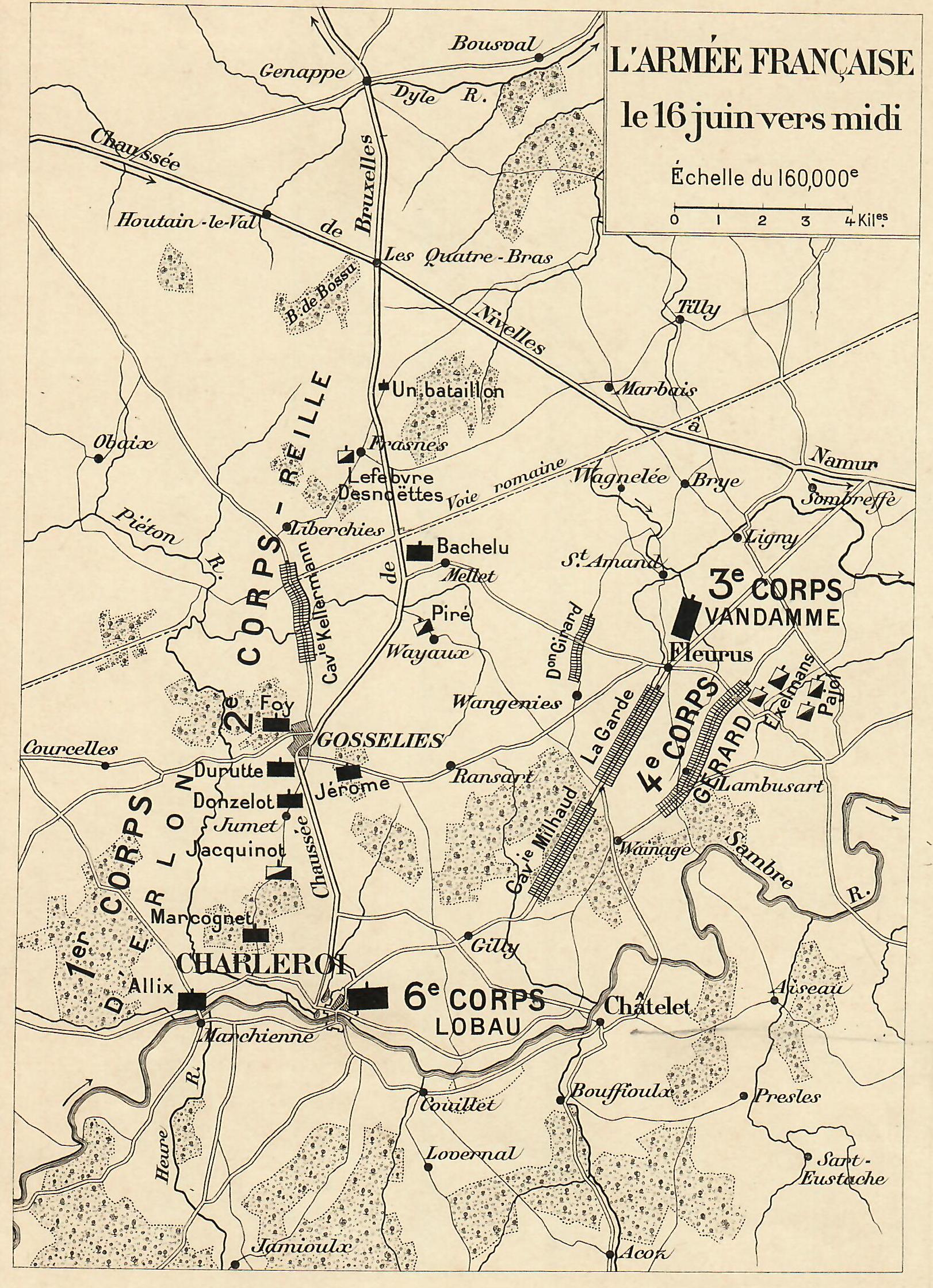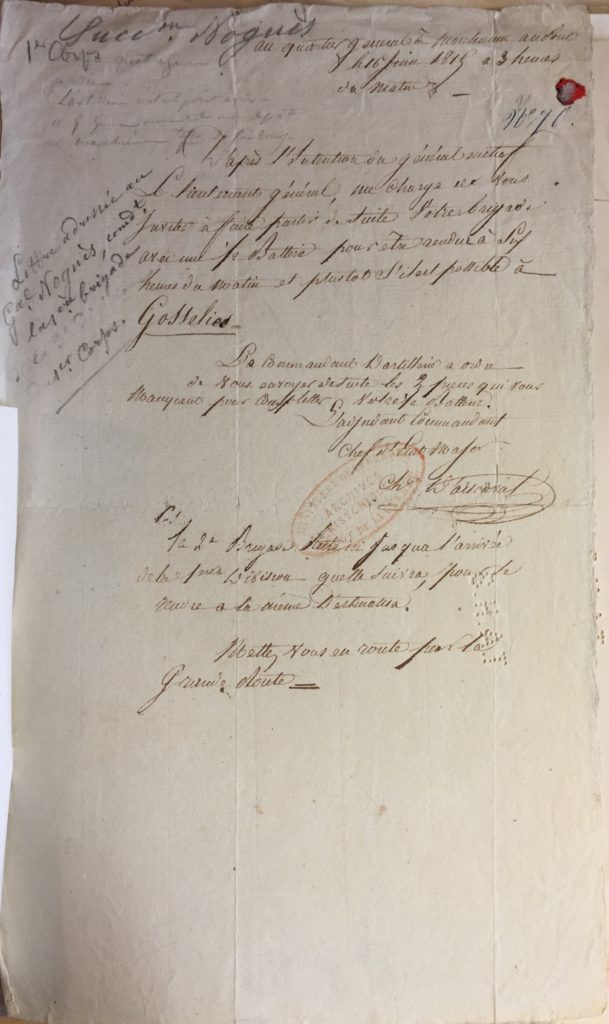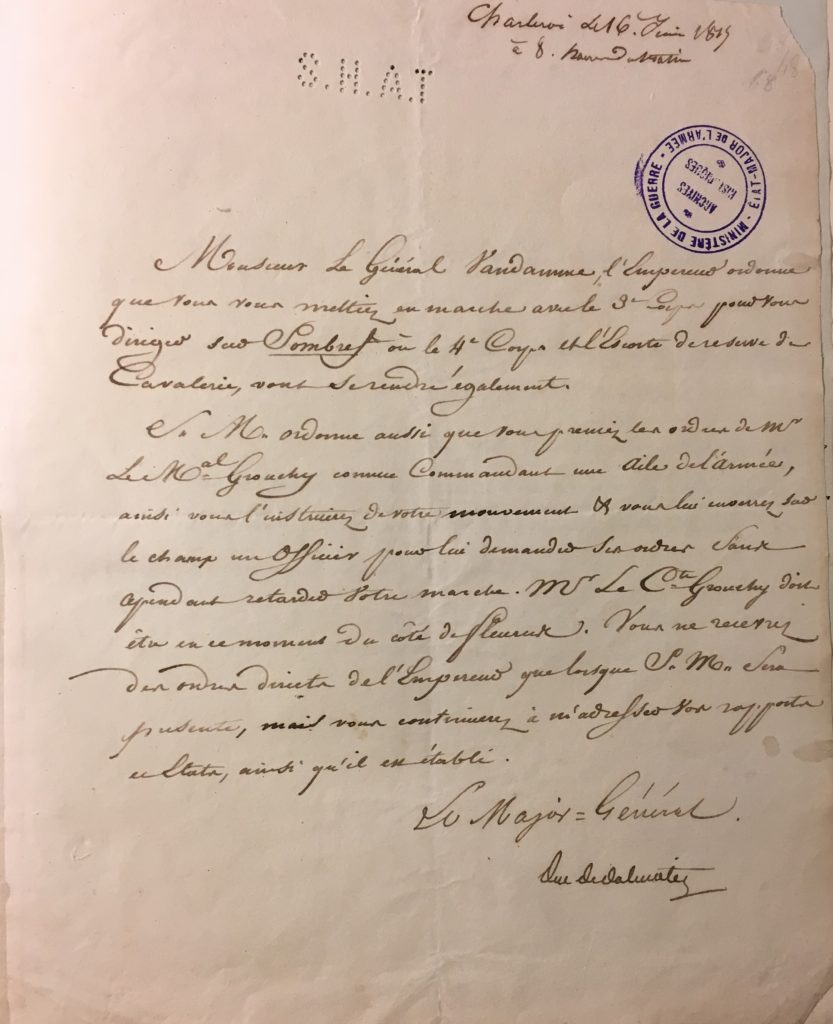
June 16 - On to Brussels!
At 3am on June 16, Adjudant Commandant Chevalier d’Arsonval, chef d’état-major if 1st Corps’ 3rd Infantry Division under the command of Marcognet, sent Général Noguès, commander of the 1st Brigrade, orders to march to Gosselies:
Au quartier général à Marchienne au Pont
le 16 juin 1815 à 3 heures du matinD’après l’intention du général en chef le lieutenant général, me charge de vous inviter à faire partir de suite votre brigade avec une ½ batterie pour être rendue à six heures du matin et plus tôt s’il est possible à Gosselies.
Le Commandant d’Artillerie a ordre de vous envoyer de suite les 2 pièces qui vous manquent pour completter votre ½ batterie.
L’adjudant Commandant
Chef d’Etat MajorCher d’Arsonval
P.S. la 2e brigade reste ici jusqua l’arrivée de la 1ere division quelle suivra pour se rendre a la même destination.
Mettez vous en route pour la grande route.Service Historique de la Défense, Armée du Nord – 11 au 21 juin – 1815, GR 15 C 5

Given Soult’s orders the evening of June 15, d’Erlon was going to gather his Corps at Gosselies. The 1st Brigade of the 3rd Division was ordered to march right away and to arrive before 6am, while the 2nd Brigade would depart once the 1st Division had arrived on the Sambre.
According to the Registre du major-général, Soult’s second order of the day was sent to Ney around 5 am:
Charleroi, le 16 Juin 1815.
Monsieur le maréchal, l’empereur vient d’ordonner M. le Comte de Valmy, commandant le 3e corps de cavalerie, de le réunir et de le diriger sur Gosselies où il sera à voire disposition.
L’intention de Sa Majesté est que la cavalerie de là garde, qui a été portée sur la route de Bruxelles, reste en arrière et rejoigne le restant de la Garde Impériale ; mais, pour qu’elle ne fasse pas de mouvement rétrograde, vous pourrez, après l’avoir lait remplacer sur la ligne, la laisser un peu en arrière, où il lui sera envoyé des ordres dans le mouvement de la journée. M. le lieutenant général Lefebvre-Desnouettes enverra, à cet effet, un officier pour prendre des ordres.
Veuillez m’instruire si le 1er corps a opéré son mouvement, et quelle est, ce matin, la position exacte des 1er et 2e corps d’armée, et des deux divisions de cavalerie qui y sont attachées, en me faisant connaître ce qu’il y a d’ennemis devant vous, et ce qu’on a appris.Le Major Géneral
duc de dalmatieArchives Nationales, Pierrefitte-sur-Seine, Papiers du maréchal Ney, 137 AP/18
Translated:
Marshal, Emperor has just ordered the Count of Valmy, commander of the 3rd Cavalry Corps, to assemble and lead it to Gosselies where it will be available.
The intention of his Majesty is that his Guard Cavalry that was placed on the road to Brussels, remain behind and join the rest of the Imperial Guard; but so that it does not make a retrograde movement, it can, after being substituted on the line, remain slightly to the rear, where orders will be sent in the movement of the day; for this General Lefebvre-Desnouettes will send an officer to take the orders.
Please inform me whether the First Corps has made its move, and what is this morning the exact position of the 1st and 2nd Corps, and of the two attached cavalry divisions, while noting what is in front of you and what you learned.
Ney responded, according to Reille from Documents inédits (the original copy found in Ney’s papers, 137 AP/18), but we do not have this document. Soult would respond by writing Ney orders at approximately 8am. While units in the rear were being moved to the front, the vanguard on the left was basically stationary despite daylight for several hours.
On the right, Grouchy had been organizing his cavalry and reporting to Napoleon since 5am, and in both the 5am and 6am hour, there are copies of letters written to Napoleon informing him of Prussians arriving in and around Sombreffe from Namur, as this letter from 6am states:
Le 16 juin 1815, 6h du matin.
Le Mal Grouchy à l’Empereur.
Sire,
Je viens d’être informé par le Gal Girard que l’ennemi continue à se porter en force par Sombref, sur les hauteurs qui environnent le moulin de Brie. Je m’empresse de transmettre à Votre Majesté ce nouvel avis confirmatif de celui que je lui ai fait parvenir il y a une heure.
Je suis, etc.Signé le Mal Grouchy.
P.C.C. à l’imprimé du Mal Grouchy
communiqué par le Comdt du Casse
en juin 1865.
Le commis chargé du travail :
D. Huguenin
Lobau and 6 Corps were ordered to take a position between Charleroi and Fleurus. Lobau’s 6th Corps is sometimes claimed to have been forgotten in Charleroi. This was not the case. In addition to protecting the parcs and baggage, it protected against any unexpected thrust from the west by Wellington. This was the role d’Erlon had been filling, but 1st Corps was now expected in the front, and under Ney’s command.
The Guard was ordered to march to Fleurus. Gérard and Vandamme were ordered to Sombreffe, and to take orders from Grouchy unless Napoleon was present, as seen in this original 8am order to Vandamme:
Charleroi Le 16 Juin 1815
à 8 heures du matinMonsieur Le Général Vandamme, l’Empereur ordonne que vous vous mettiez en marche avec le 3e Corps pour vous diriger sur Sombref où le 4e Corps et l’Escorte de reserve de Cavalerie vont se rendre également.
S.M. ordonne aussi que vous preniez des ordres de Mr Le Mal Grouchy comme Commandant une Aile de l’armée, ainsi vous l’instruirez de votre mouvement & vous lui enverrez sur le champ un officier pour lui demander des ordres sans cependant retarder votre marche. M Le Cte Grouchy doit être en ce moment du côté de Fleurus. Vous ne recevrez des ordres directes de l’Empereur que lorsque S.M. sera presente, mais vous continuerez à m’adresser vos rapports et Etats, ainsi qu’il est établi.Le Major Général
duc de dalmatieService Historique de la Défense, Correspondance de l’Empereur Napoléon et du Major Général, GR 17 C 193
Translated:
General Vandamme, the Emperor orders that you march with the 3rd Corps, directed to Sombreffe where the 4th Corps and the Reserve Cavalry Corps will also go.
H.M. also orders that you take orders from Marshal Grouchy as commander of an army wing. Thus he will instruct you in your movement and you will send an officer to him at once to ask him his orders, without however delaying your march. Count Grouchy must be at this time on the outskirts of Fleurus, you will receive direct orders from the Emperor when H.M. is present; but you will continue to address your reports and records to me as established.

By mid morning, Napoleon revealed his plan – push the Prussian 1st Corps to the east, and force march to Brussels. Though Grouchy reported Prussian forces marching into Sombreffe, Napoleon clearly did not believe it could be significant.
My cousin, I send my Aide-de-Camp General Flahaut to you, who brings you this letter. The Major General should have given you orders but you will receive mine first because my officers move faster than his. You will receive the day’s movement orders, but I want to write to you in detail, because it is of the highest importance.
I am sending Marshal Grouchy with the 3rd and 4th Infantry Corps to Sombreffe; I am taking my Guard to Fleurus, and I will be there in person before midday, I will attack the enemy if I find them there, and I will clear the roads as far as Gembloux. There, according to what will happen, I shall come to a decision, perhaps at three o’clock in the afternoon, perhaps this evening. My intention is that, immediately after I have made up my mind, you will be ready to march on Brussels. I will support you with my Guard who will be at Fleurus or Sombreffe, and I wish to arrive at Brussels tomorrow morning. You will march this evening; if I make up my mind at an early hour then you will be informed of it during the day and then this evening will go three or four leagues and reach Brussels tomorrow by seven o’clock in the morning.
You can arrange your troops in the following way: The first division, two leagues in front of Quatre Bras, if there is no harm; six divisions of infantry around Quatre Bras, and a division at Marbais, so that I can draw it to me at Sombreffe, if I need; it would not otherwise delay your march; Comte de Valmy’s Corps, which has 3,000 Elite Cuirassiers, will be placed at the intersection of the Roman and Brussels roads, so that I can draw it to me if needed. As soon as I take my course of action, you will send him the order to come join you.
I will want to have the Guard Division with me, commanded by General Lefebvre-Desnoëttes, and I am sending you two divisions of Comte de Valmy’s Corps to replace it. But, in my current endeavor, I prefer to place Comte de Valmy so as to be recalled if I need him, and I do not wish to cause General Lefebvre-Desnoëttes to make unnecessary marches, since it is likely that I will decide this evening to march on Brussels with the Guard. However, cover Lefebvre’s division with d’Erlon and Reille’s Divisions of Cavalry, in order to save the Guard: if there is a skirmish with the English, it is preferable that it is on the Cavalry of the line rather than on the Guard.
I have adopted as a general principle, during this campaign, to divide my army into two wings and a reserve. Your wing will consist of four divisions of the 1st Corps, four divisions of the 2nd Corps, two divisions of Light Cavalry, and two divisions of the Comte de Valmy’s Corps. That should be roughly 45 to 50,000 men.
Marshal Grouchy will have about the same force and will command the right wing.
The Guard will form the reserve, and I will move to one or the other wing, according to circumstances. The Major General gives the most precise orders so that there is no difficulty in obeying such orders that you receive; the Corps commanders will take my orders directly when I am present.
According to circumstances, I will diminish one wing or the other, to strengthen my reserve.
You understand the considerable importance in taking Brussels. This may also lead to incidents, because such a swift and abrupt movement will isolate the English army from Mons, Ostend, etc. I want your arrangements to be well made, so that at the first order your eight divisions can go quickly and without obstacles to Brussels. Charleroi, June 16, 1815,
NapoléonArchives Nationales, Papiers du maréchal Ney, 137 AP/5
Napoleon did not expect any great battles on June 16, and his goal was to occupy Brussels by the morning.
Soult’s orders that Napoleon referenced were sent around 8 am:
Charleroi, June 16, 1815
Marshal, the Emperor orders that you have the 2nd and 1st Army Corps, as well as the 3rd Cavalry Corps that was placed at your disposal and direct them to the intersection of the roads known as the Trois-Bras, where they will take their position. At the same time you will send a reconnaissance, as forward as possible on the road to Brussels and Nivelles, where the enemy has probably retreated. H.M. wishes that, if there is no harm, you establish a division with cavalry at Genappe, and orders that you march another division in the direction of Marbais to cover the space between Sombreffe and Trois Bras. You will place, close to this division, the cavalry division of the Imperial Guard commanded by General Lefebvre-Desnouettes, as well as the 1st Hussars Regiment which was detached yesterday towards Gosselies.
The Corps that will be at Marbais will also plan to support the movements of Marshal Grouchy on Sombreffe, and support you at the position at the Trois Bras, if that becomes necessary. You will recommend to the General who will be at Marbais, to scout well in all directions, particularly those of Gembloux and Wavre.
If, however, General Lefebvre-Desnouettes’ Division is too engaged on the Brussels road, you will leave it there and replace it at Marbais by the 3rd Cavalry Corps, that will be under command of the Count of Valmy, and by the 1st Hussars Regiment.
I have the honor to advise you that the Emperor will march on Sombreffe, where, according to the orders of H.M., Marshal Grouchy must move with the 3rd and 4th Infantry Corps, and the 1st, 2nd and 4th Cavalry Corps. Marshal Grouchy will occupy Gembloux.
Please report to me as well as to the Emperor about your arrangments, to execute the order that I send to you as well as all that you will have learned about the enemy.
H.M. desires me to tell you to prescribe to the Generals commanding the army corps to keep their troops united, and send isolated men back to their units, to maintain perfect order in the troops and rally all the artillery carts and ambulances that have been left behind.
Napoleon also wrote to Grouchy:
Mon cousin, je vous envoie La Bedoyère, mon aide-de-camp, pour vous porter la présente lettre. Le Major général a dû vous faire connaître mes intentions, mais comme il a des officiers mal montés, mon aide-decamp arrivera peut-être avant. Mon intention est que comme commandant l’aile droite vous preniez le commandement du 3e corps, que commande le Gal Vandamme, le 4e corps, que commande le Gal Gérard, les corps de cavalerie que commandent les Gaux Pajol, Milhaud, Exelmans ce qui ne doit pas faire loin de cinquante mille hommes. Rendez-vous avec cette aile droite à Sombref. Faites partir en conséquence de suite les corps des Gaux Pajol, Milhaud, Exelmans et Vandamme, et sans vous arrêter, continuez votre mouvement sur Sombref.
Le 4e corps, qui est à Capel, reçoit directement les ordres de se rendre à Sombref sans passer par Fleurus. Cette observation est importante parce que je porte mon quartier général à Fleurus, et qu’il faut éviter les encombrements. Envoyez de suite un officier au Gal Gérard pour lui faire connaître votre mouvement et qu’il exécute le sien de suite.Mon intention est que tous les Généraux prennent directement vos ordres. Ils ne prendront les miens que lorsque je serai présent, je serai entre dix et onze heures à Fleurus. Je me rendrai à Sombref, laissant ma garde, infanterie et cavalerie, à Fleurus. Je ne la conduirais à Sombref qu’en cas qu’elle fût nécessaire. Si l’ennemi est à Sombref, je veux l’attaquer; je veux même l’attaquer à Gembloux et m’emparer aussi de cette position mon intention étant, après avoir connu ces deux positions, de partir cette nuit et d’opérer avec mon aile gauche que commande le Maréchal Ney, sur les Anglais. Ne perdez donc point un moment, parce que plus vite je prendrai mon parti, mieux cela vaudra pour les suites de mes opérations. Je suppose que vous êtes à Fleurus, communiquez constamment avec le Gal Gérard, afin qu’il puisse vous aider pour attaquer Sombref, s’il était nécessaire la division Girard est à portée de Fleurus; n’en disposez point à moins de nécessité absolue, parce qu’elle doit marcher toute la nuit. Laissez aussi ma jeune garde et toute son artillerie à Fleurus.
Le comte de Valmy, avec ses deux divisions de cuirassiers, marche sur la route de Bruxelles. Il se lie avec le Mal Ney pour contribuer à l’opération de ce soir à l’aile gauche.
Comme je vous l’ai dit, je serai de dix à onze heures à Fleurus. Envoyez-moi des rapports sur tout ce que vous apprendrez. Veillez à ce que la route de Fleurus soit libre. Toutes les données que j’ai sont que les Prussiens ne peuvent point nous opposer plus de quarante-mille hommes.
The key passage is the final paragraph, here translated:
As I have said to you, I will be in Fleurus at ten to eleven o’clock. Send me reports on all that you learn. Be sure that the Fleurus route is free. All the information I have suggests that the Prussians cannot oppose us with more than 40,000 men.
Napoleon believed that at most, he was facing the Prussian 1st Corps augmented with some nearby elements. His orders to both Ney and Grouchy demonstrated that he believed there were no significant forces at Quatre-Bras or Sombreffe. Indeed, his orders suggested the French move into and beyond these locations – not fight for them.
At the same time, he had established two wings of significant strength, with a reserve in the center that could support either. While Ney and Grouchy had been put in command of the left and right wing, Napoleon was in command when present, and Napoleon was placing himself where any potential action could be. Ney and Grouchy were points of contact for managing maneuvers. Napoleon did not expect either to direct a battle.
The lack of urgency on June 16 can be explained by several factors. First, and possibly foremost, Napoleon did not believe there was a need. So far, what he believed the evening of June 15 had been confirmed – or he chose to believe it. Second, to carry out his plans, troops from the rear had to close with the front. Finally, he may have felt it acceptable to allow for some morning rest as he expected half his army to march through the night.
The featured image from Stoffel’s notes provides a good overview of the French advance on the morning of June 16.
